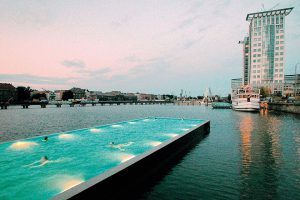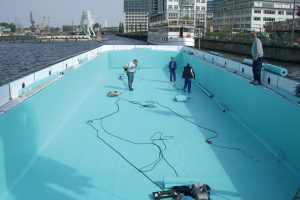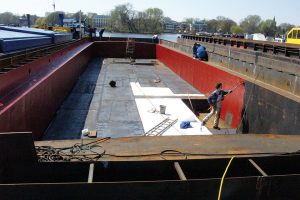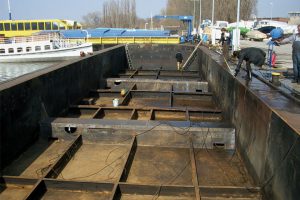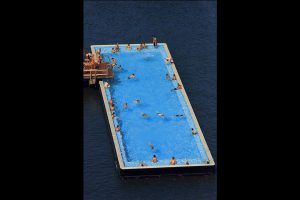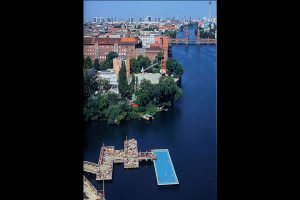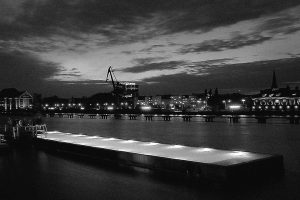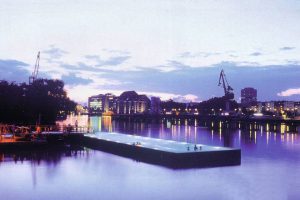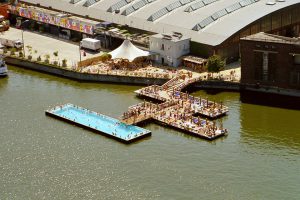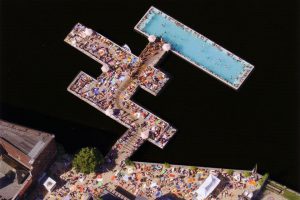Badeschiff. Piscina flotante en Berlín
Datos técnicos:
Arquitectos: Fernando Menis, Felipe Artengo Rufino, José Maria Rodriguez Pastrana con Gil Wilk
Artista: Susanne Lorenz
Emplazamiento: Berlín, Alemania. 52°29’52.6″N 13°27’13.4″E
Presupuesto: 400.000 euros
Superficie Construida: 240 m2
Estado: Obra construida 2004.
Promotor: Stadkuntprojeckte e.V. Berlín, Heike Catherina Müller.
Constructora: Ute Schimmelpfennig für m.o.l.i.t.o.r. GmbH, Berlín.
Contratista: MBS-Márkische Bunker und Service GMBH & KG, Berlín.
2003 1er Premio Concurso Internacional Seleccionada en la VIII Bienal de Arquitectura Española, Madrid
2005 IV Premio Europeo del Espacio Público Urbano, Bruselas
2006 X Bienal de Arquitectura de Venecia, en el pabellón alemán “Convertible City”, Italia
2006 Premio de Arquitectura de Berlín (Architekturpreis Berlin), Alemania
2006 Premio de la Construcción con Madera(Holzbaupreis), premio de las regiones de Berlin, Brandenburg, Mecklenburg-Vorpommern y Sachsen-Anhalt, Alemania
2006 Premio Internacional de Paisajismo, IULA
2007 BDA Premio de Arquitectura, Nike para precio y calidad
2007 Real Estate Award Berlin
2007 Medalla de Plata del los Premios IOC / IAKS AWARD, International Association for Sports and Leisure Facilities
2007 Seleccionada para la Bienal de Venecia, Italia
Descripción: Siguiendo la tradición de las piscinas públicas en el Spree de finales del siglo XIX, este proyecto devuelve a la ciudad de Berlín una relación más cercana con el río a través de una piscina flotante dentro de él. Se trata de una piscina en el centro de la ciudad de Berlín, en el río, en una antigua barcaza de carbón, como las que aún surcan cada día el río transportando materiales, reconvertida en piscina, con una “playa” formada por plataformas de madera que permiten el ocio, el relax y el disfrute.
Desde los tiempos de la antigua Roma, las piscinas y los baños termales han sido lugares de encuentro y de disfrute de la naturaleza y el agua. El Spreebrücke –como se le conoce en alemán-, es un claro ejemplo de ello. El proyecto toma tanto de manera literal como figurada el concepto de puente. El puente se ve no sólo como una conexión entre dos puntos, sino también como una línea de conexión, punto de encuentro, dentro de la ciudad.
Antiguamente el río Spree había desempeñado un importante papel en la vida social de Berlín. Como en otras capitales europeas, durante los siglos XVIII y XIX la construcción de puentes en el centro de la ciudad se convirtió en una fecunda actividad que dio lugar a ejemplos cargados de simbolismo y representatividad. Durante la segunda guerra mundial, todos los puentes de Berlín, con la excepción del de Weidendammer y el de Schilling, quedaron total o parcialmente destruidos por los bombardeos. Los límites entre el Berlín Este y el Oeste no fueron dibujados únicamente por el muro que ahora pertenece a la historia sino a través de la supresión de los puentes que cruzaban el río.
Los puentes que se construyeron después de la guerra son austeras obras de ingeniería que, evitando todo desvío de la funcionalidad, se limitaron a dar una respuesta eficaz a las necesidades de comunicación surgidas durante el proceso de reconstrucción de Alemania. Poco después, la ciudad dividida acabaría de dar la espalda a su río, que coincidía mayoritariamente con la frontera entre el este y el oeste. Es más, la presencia del Spree llegó a ser percibida como una parte más del muro que partió Berlín en dos durante muchos años.
Por otro lado a principios del siglo XX a orillas del Spree había quince baños públicos muy frecuentados. Algunos eran espacios definidos dentro del propio río y otros eran embalses cercanos, conocidos como Badeschiffe (barcos de baño), que se alimentaban con sus aguas. Sin embargo, la creciente contaminación de estas aguas ya provocó el cierre de todos los baños públicos antes de la primera guerra mundial.
Desde la unificación alemana en 1989, el gobierno realiza formidables inversiones en la restauración y en la construcción de nuevos puentes, nuevas conexiones.
Spreebrücke Berlín es un proyecto que aborda ese reto de anudar de nuevo la ciudad.El equipo de Fernando Menis asumió la idea de la reunificación aprovechando no solo la existencia del Spree, sino también sus intensos usos históricos industriales. Es precisamente ese uso previo industrial lo que sirve como inspiración para esta nueva intervención, además de la costumbre de los berlineses de ir al río a principios del siglo XX anteriormente mencionada.
Todo este proyecto, tanto arquitectónico como artístico, fue promovido por el Stadtkunstprojekte e.V., y comisariado por Heike C. Muller. La asociación estatal alemana Stadkunst Projekte (Proyectos Culturales en la Ciudad) convocó en 2002 un concurso internacional para integrar el río Spree en la ciudad de Berlín. El StadtKunstProjekte puso en marcha un concurso múltiple que, bajo el nombre de “con_con” [conexiones construidas], reunió a artistas, arquitectos e ingenieros para el desarrollo de una serie de intervenciones que perseguían la recuperación de los puentes y las orillas del Spree como espacios vitales de la ciudad. Dentro de estas intervenciones, el Spreebrücke parte de la concepción del puente como elemento de comunicación, no solo entre dos puntos, sino también entre la ciudad y el río. El estudio canario de arquitectura y la artista berlinesa Susanne Lorenz, ganaron el concurso al que se presentaron otros treinta y dos participantes de más de doce países.
El resultado es un proyecto innovador que anima el río Spree creando un lugar de ocio como mejor manera de optimizar y activar esa parte de la ciudad, situada en el transitado barrio de Treptow, en Kreuzberg.
El proyecto se basa en la reutilización, como piscina pública flotante, de una embarcación hundida, proponiendo un nuevo espacio de ocio junto al antiguo muro de Berlín. El resultado es una piscina de agua azul caribe y cristalina, sumergida, en contraposición, en las aguas oscuras del río Spree, a la que se accede a través de un puente que surge desde una playa ficticia. Ópticamente, parece que el baño se realice en el río, aunque de hecho la inmersión es en una antigua gabarra industrial, un barco de carga que se utilizaba para transportar carbón que queda sumergida en las aguas de un río que busca formar parte activa de la ciudad.
El Spreebrücke es, por tanto, una nueva zona de baño flotante que se puede desmontar y transportar a cualquier punto del río. Actualmente está instalada en el sudeste de la ciudad, poco antes del puente de Oberbaumbrücke. Consta de una piscina, una playa artificial, un puente y un contenedor. Primero la idea fue hacer una piscina redonda, y el equipo, junto con Frei Otto, que se encontraba de vacaciones en Tenerife, intentó formalizar esta idea, pero finalmente, buscando una propuesta de más bajo coste, se optó por el proceso de transformar, reciclar, un schubleichter –tipo de barcaza de transporte muy común en el Spree– que fue muy interesante. Después de retirar la cubierta del barco, el casco forma un vaso flotante, rectangular, que define sobre la superficie del río un recinto rectangular de agua limpia donde se puede nadar en verano y patinar en invierno. Potentes luminarias azules y verdes encastradas en las paredes interiores del vaso iluminan la superficie del agua con los colores veraniegos, añorados por los berlineses, del Caribe o las Islas Canarias, como una línea azul, luminosa y permeable, para Berlín. Water flying over water. En función del caudal del Spree, la piscina flota o descansa sobre su lecho, de modo que su superficie puede quedar enrasada o sobresalir por encima el nivel del río.
Al aproximarnos al río, entre la arena se abre un camino hacia dos grandes plataformas de madera, que juegan el papel de playas artificiales donde tomar el sol, y flotan al lado de la piscina. Éstas conectan con la vieja barcaza de cargo convertida en “barco de baño”. La gabarra, un antiguo Schubleichter reciclado, cuyo tamaño es óptimo para natación por medir 32’5 metros de longitud por 8’2 de ancho, y poco más de dos metros de profundidad, contiene 400.000 litros de agua ligeramente clorada que se mantiene a 24°C. El ingeniero del grupo, Juan José Gallardo, calculó la carga liquida y el peso propio de la gabarra para que, totalmente llena, quedase elevada 70 centímetros sobre la superficie del río. La idea era hacer coincidir el nivel del agua con el del borde de la piscina de tal forma que los bañistas se sintiesen completamente inmersos en el cauce del río. Para ello, y por medio de las curvas de calados, se añadió a la cámara de aire contenida en la doble carcasa de estas embarcaciones de carga, una base de poliestireno expandido que disminuye el peso de la carga y consigue el desplazamiento deseado.
Representa el arquetipo universal del espacio público ideal por su capacidad de imbricar la arquitectura y la ciudad sin establecer ninguna frontera entre ellas. Por otro lado, el Schubleichter reciclado que conforma el vaso de la piscina nos remite a una dimensión local del proyecto que recoge la rica tradición de la industria náutica del río Spree.
Con la propuesta de un “barco de baño” contemporáneo, el equipo redactor quiso recuperar la práctica de los baños e incorporar esta actividad a los bares de las playas. El nuevo “puente Spree” conecta con el pasado, con una tradición perdida, y con el presente, como lugar de comunicación. La idea fascinó a la compañía privada ARENA, que lo construyó y lo mantiene anclado frente a sus instalaciones de ocio como un elemento de gran potencia atractora.
La colaboración de distintos profesionales transformó una tradición perdida en una experiencia poética y Berlín ganó una perspectiva completamente nueva de su ciudad. El proyecto se ha convertido desde su inauguración, hace ya doce años, en uno de los referentes de actividades al aire libre de esta zona al sureste del centro, motor de cambio y actividades de este barrio multi-étnico de Berlín.

